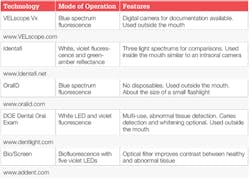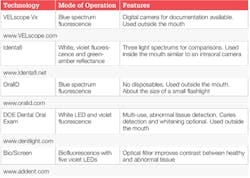What can you do? Many resources are available for Oral Cancer Awareness Month
By KIM MILLER
Approximately 48,250 people in the U.S. will be newly diagnosed with oral cancer this year; 132 new cases will be diagnosed each day, and one person will die from oral cancer every hour 24 hours a day, seven days a week, 365 days per year. Unfortunately, the survival rate for oral cancer has not significantly improved in decades. In fact, the death rate associated with oral cancers is higher than that of cervical and testicular cancers, Hodgkin's lymphoma, laryngeal cancer, and endocrine system cancers such as thyroid or skin cancers such as malignant melanoma.
The fastest growing segment of oral cancer patients is young, healthy, nonsmoking individuals due to the connection to the HPV virus. We cannot stop this virus from spreading; we can however, save lives with professional involvement and raising public awareness. It is very unfortunate that in spite of these statistics, oral cancer awareness among the general population is still very low.
It's also interesting to note that periodontal disease plays a role in head and neck cancers. A study performed at the Department of Dentistry and Maxillofacial Prosthetics, Roswell Park Cancer Institute between 1999 and 2005 suggests that chronic periodontitis is an independent risk factor for head and neck squamous cell carcinoma (HNSCC). They found that each millimeter of alveolar bone loss was associated with >4-fold increased risk of HNSCC, after adjustment for age, gender, race/ethnicity, marital status, smoking status, alcohol use, and missing teeth. The strength of the association was greatest in the oral cavity, followed by oropharynx and larynx. In fact 90% of oral cancers are squamous cell carcinomas, with 30% beginning in the tongue, 17 % in the lip and 14 % in the floor of the mouth.1,2,3
What Can You Do?
It's time for dental hygienists to take a stand, "be part of the change" and screen every patient, every time for signs of oral head and neck cancers. The Oral Cancer Foundation (OCF) is making it easier than ever to save lives through early detection when you join their national screening campaign. This is your opportunity to get involved, give back to your communities and raise public awareness about the need for regular oral head and neck cancer screenings.
Joining the OCF campaign is easy! Simply visit oralcancerfoundation.org and add your free screening event to the OCF calendar.
Once you register your event, the following free support materials will be sent to your office:
- Patient education brochures covering risk factors, signs, and symptoms
- Activist buttons for the staff
- Official oral cancer awareness wristbands for the staff
- A certificate of participation
- An oral cancer fact sheet to display in your office
- An HPV and oral cancer fact sheet to display in your office.
There are also a variety of forms available for download, including a press release, screening release form, referral forms, ideas/suggestions on ways to market your event, and a poster for promotional use.
All offices participating will receive a certificate of partnership with the Oral Cancer Foundation and Oral Cancer Awareness Month. It's perfect for framing in your office, letting your patients know you are a dental office that cares about your patient's health and is actively involved in oral cancer screenings. And if you'd like a T-shirt telling the world and your patients that you are part of the change, visit ocfstore.org to order.
Walking Your Talk!
Providing a comprehensive external head and neck cancer screening as well as an intraoral cancer screening is the standard of care. We all learned how to perform these screenings during our professional education, but rarely do we see them being delivered as part of a new patient exam or a routine hygiene visit. In fact, a survey published in the Journal of Dental Hygiene in the fall of 2011 states that almost all dental hygienists reported they did not perform extra oral palpation and only one third performed intraoral exams.4
Both of these exams can be provided in just a few minutes. But a very real challenge is remembering to do these exams.
You won't be surprised to learn that Young Dental has you covered. The company's burgundy prophy angles will serve as a reminder to do the exams. Burgundy is the signature color for oral, head, and neck cancer awareness. This month, you can get a free box when you buy one box. Visit youngdental.com or contact your dealer.
For a live patient demonstration of a head and neck screening, view my video on YouTube. Search "Kim Miller Head Neck Exam." And if you email me, I will gladly send you a PDF of the visual aid the patient is holding, which builds value for the patient and shows the location of the lymph node chains.
For the intraoral screening, visit sixstepscreening.org and follow the six steps:
1. Tongue and gauze
2. Lip and cheek roll
3. Double-digit probe
4. Palate tickle
5. Neck caress
6. Tonsil "Ahh"
While an intraoral visual inspection and palpation is acceptable, the use of a fluorescing device to enhance visualization is even better (see chart). The proven science behind fluorescing devices is very straightforward. Healthy tissue reflects the light back to the clinician, while unhealthy tissue will absorb the light causing suspicious areas/tissue to appear dark. There are many devices available to aid clinicians in early detection. RDH
References
1. Cancer Epidemiol Biomarkers Prev 2009;18(9):2406-12)
2. Advanced Gun Disease Linked to Increased Head and Neck Cancers, posted on 2009-09-22
3. Chronic Periodontitis and the Incidence of Head and Neck Squamous Cell Carcinoma, Department of Oral Diagnostics Sciences, The State University of New York, Buffalo New York, Cancer Epidemiol Biomarkers Prev 2009;18(9):2406-12
4. JDH, Vol. 85, No.4, Fall 2011
KIM MILLER, RDH, BSDH, is the co-founder of PerioFrogz.com, an information-based website providing free current oral-systemic research summaries and patient education downloads. Kim is also a coach with Inspired Hygiene, delivering customized hands-on training. She speaks internationally, writes articles and webinars, and enjoys clinical dental hygiene. Kim lives in Arizona and welcomes you to contact her at [email protected].

